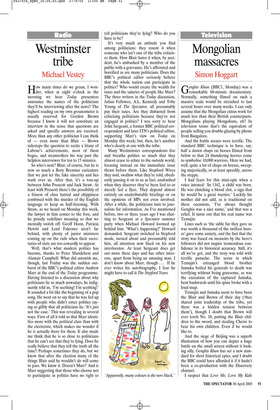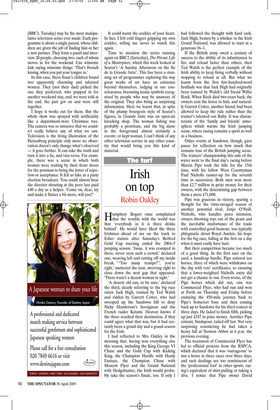Mongolian massacres
Simon Hoggart
Genghis Khan (BBC1, Monday) was a remarkable 60-minute documentary. Normally, something filmed on such a massive scale would be stretched to last several hours over many weeks. I can only assume that the Mongolian extras work for much less than their British counterparts. Mongolians playing Mongolians, eh? In television terms that’s the equivalent of people selling you double-glazing by phone from Bangalore.
And the battle scenes were terrific. The standard BBC technique is to have, say, half a dozen chaps on horses filmed from below so that 24 thundering hooves come to symbolise 10,000 warriors. Here we had, well, quite a lot of chaps on horses, sweeping majestically, or at least speedily, across the steppe.
I had fears for this mini-epic when a voice intoned: ‘In 1162, a child was born. He was clutching a blood clot, a sign that he would be a great warrior.’ Luckily his mother did not add, as is traditional on these occasions, ‘I’ve always thought Genghis was a nice name,’ and that was a relief. It turns out that his real name was Temujin.
Lines such as ‘the sable fur they gave us was worth a thousand of the swiftest horses’ gave some anxiety, and the fact that the story was based on memoirs by the hero’s followers did not inspire tremendous confidence in its historical accuracy. Still, it’s all we’ve got, and the story was told with terrific panache. The scene in which Temujin’s estranged blood brother Jamuka boiled his generals to death was terrifying without being gruesome, as was the execution of the captured Jamuka, bent backwards until his spine broke with a loud snap.
Temujin and Jamuka seem to have been the Blair and Brown of their day (‘they shared joint leadership of the tribe, yet there was a hidden tension between them’), though I doubt that Brown will ever torch No. 10, putting the Blair children to the sword, and stealing Cherie to bear his own children. Even if he would like to.
And the siege of Beijing was a superb illustration of how you can depict a huge battle on the small screen without it looking silly. Genghis Khan has set a new standard for short historical epics, and I doubt the BBC could have afforded it if it hadn’t been a co-production with the Discovery channel.
I suspect that Love Me, Love My Kids (BBC1, Tuesday) may be the most manipulative television series ever made. Each programme is about a single parent, whose children are given the job of finding him or her a new partner. They form a panel and interview 20 people, choosing two, each of whom moves in for the weekend. Cue winsome kids saying winsome things: ‘That’s fwench kissing, when you put your tongue in.’ In this case, Steve Isaac’s children found two apparently charming and talented women. They (not their dad) picked the one they preferred, who popped in for another weekend stay, and, we were told at the end, the pair got on and were still together.
I hope it works out for them. But the whole show was sprayed with artificiality like a department-store Christmas tree. The camera was so intrusive that we couldn’t really believe any of what we saw. Television is the living illustration of the Heisenberg principle only more so; observation doesn’t only change what’s observed — it goes further. It can take the truth and turn it into a lie, and vice-versa. For example, there was a scene in which both women were waiting by their front doors for the postman to bring the letter of rejection or acceptance. It felt as fake as a party election broadcast. You could almost hear the director shouting at the poor lass paid £40 a day as a helper. ‘Come on, dear, try and make it flutter a bit more, will you?’ It could warm the cockles of your heart. In fact, I felt cold fingers gripping my own cockles, telling me never to watch this again.
Time to mention the series running again on BBC2 (Saturday), The Private Life of a Masterpiece, which this week looked at Seurat’s ‘A Sunday Afternoon on the Ile de la Grande Jatte’. This has been a stunning set of programmes exploring the way great works of art have an existence beyond themselves, lodging in our consciousness, becoming iconic symbols recognised by people who may be unaware of the original. They also bring us surprising information. Here we learnt that, in spite of the plump bourgeois style of Seurat’s figures, la Grande Jatte was an open-air knocking shop. The woman fishing was probably a prostitute, and the big dame in the foreground almost certainly a cocotte, or kept woman. I can’t think of any other television service in any other country that would bring you this kind of material.





















































 Previous page
Previous page